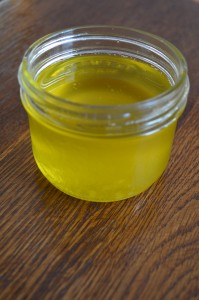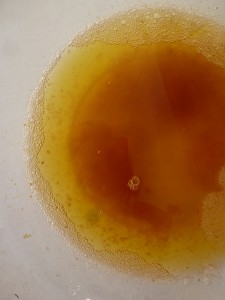In culinary school I was taught that beurre blanc, while not a mother sauce, is a sauce of great importance. Interestingly, though it bears resemblance to Hollandaise, it doesn’t have nearly the same number of variations or “lesser sauces”. In my culinary text there were only two beurre blanc variations: herb butter sauce (throw some chopped herbs into your beurre blanc), and beurre rouge (use red wine in the initial reduction instead of white).
In the Eleven Madison Park cookbook there are at least five variations on classic beurre blanc:
- Lemon Beurre Blanc. Using a lemon reduction instead of wine and vinegar. I haven’t made the EMP recipe yet, but it calls for an insane volume of 1 cup lemon
…
Continue reading.
 Clarified butter is butter from which water and milk solids like protein and sugar have been removed to leave pure milk fat. As the name implies, it has a radiant clarity. As the proteins have been removed, it can be heated to frying temperatures without burning.
Clarified butter is butter from which water and milk solids like protein and sugar have been removed to leave pure milk fat. As the name implies, it has a radiant clarity. As the proteins have been removed, it can be heated to frying temperatures without burning.
Clarifying butter is simple. If you gently heat butter in a pot, this is what happens:
- The milk fat becomes liquid.
- The water content begins to evaporate, gently bubbling to the surface.
- The light whey proteins form a foam on the surface. Once the water content has been driven off, this foam dries and forms a crackly skin.
- The heavier casein proteins coagulate and fall to the bottom of the pot.
If you skim … Continue reading.
 Possibly my favourite application for rhubarb. Almost any tart fruit can be used, but the sour flavour of rhubarb marries beautifully with the nutty character of the brown butter.
Possibly my favourite application for rhubarb. Almost any tart fruit can be used, but the sour flavour of rhubarb marries beautifully with the nutty character of the brown butter.
Every time I brown butter I ask myself why I don’t do it more often. It’s quick, more or less foolproof, and one of the great, complex flavours of the kitchen. Simply put butter in a heavy pot over medium high heat, then remove once the moisture has boiled off and the milk solids have browned. If you need more guidance, you can think of browning butter like making syrup: as more and more water evaporates, the boiling point of the liquid rises. Use a candy thermometer and pull the brown … Continue reading.
I think as children most of us were taken to historical sites like Fort Edmonton to learn how the settlers made wool and horseshoes and butter. Even so, I’ll start at the beginning.
You make butter by agitating cream.
It works like this. The fat in cream is in tiny globs, each covered with a membrane that prevents the fat globs from joining together. When you agitate cream, you break these coverings, releasing the fat globs, which all rush out to join their fatty brethren and form a solid mass of butter.
To commence butter-production, fill your container half way with heavy cream. Add a pinch of salt, secure the lid, and start shaking. You don’t have to strain yourself, … Continue reading.
The personal website of Edmonton chef Allan Suddaby


 Possibly my favourite application for rhubarb. Almost any tart fruit can be used, but the sour flavour of rhubarb marries beautifully with the nutty character of the brown butter.
Possibly my favourite application for rhubarb. Almost any tart fruit can be used, but the sour flavour of rhubarb marries beautifully with the nutty character of the brown butter.